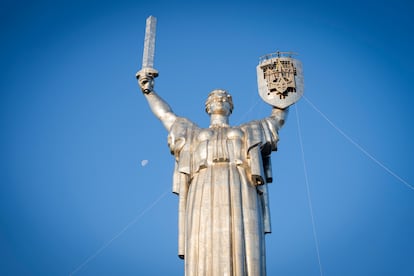Ukraine replaces Soviet hammer and sickle with trident on towering Kyiv monument
The move is part of a wider shift to reclaim Ukraine’s cultural identity from the Communist past amid Russia’s ongoing invasion

The towering Mother Ukraine statue in Kyiv — one of the nation’s most recognizable landmarks — lost its hammer-and-sickle symbol on Sunday as officials replaced the Soviet-era emblem with the country’s trident coat of arms.
The move is part of a wider shift to reclaim Ukraine’s cultural identity from the Communist past amid Russia’s ongoing invasion.
Erected in 1981 as part of a larger complex housing the national World War II museum, the 200-foot (61-meter) Mother Ukraine monument stands on the right bank of the Dnieper River in Kyiv, facing eastward toward Moscow.
Created in the image of a fearless female warrior, the statue holds a sword and a shield.
But now, instead of the hammer-and-sickle emblem, the shield features the Ukrainian tryzub, the trident that was adopted as the coat of arms of independent Ukraine on Feb. 19, 1992.
Workers began removing the old emblem in late July, but poor weather and ongoing air raids delayed the work. The completed sculpture will be officially unveiled on Aug. 24 — Ukraine’s Independence Day.
The revamp also coincides with a new name for the statue, which was previously known as the “Motherland monument” when Ukraine was part of the Soviet Union.
The change is just one part of a long effort in Ukraine to erase the vestiges of Soviet and Russian influence from its public spaces — often by removing monuments and renaming streets to honor Ukrainian artists, poets, and soldiers instead of Russian cultural figures.
Most Soviet and Communist Party symbols were outlawed in Ukraine in 2015, but this did not include World War II monuments such as the Mother Ukraine statue.
Some 85% of Ukrainians backed the removal of the hammer and sickle from the landmark, according to data from the country’s Culture Ministry released last year.
For many in Ukraine, the Soviet past is synonymous with Russian imperialism, the oppression of the Ukrainian language, and the Holodomor, a man-made famine under Josef Stalin that killed millions of Ukrainians and has been recognized as an act of genocide by both the European Parliament and the United States.
The movement away from Soviet symbols has accelerated since Russia’s full-scale invasion of Ukraine on Feb 24, 2022, where assertions of national identity have become an important show of unity as the country struggles under the horror of war.
In a statement about the emblem’s removal, the website of Ukraine’s national World War II museum described the Soviet coat of arms as a symbol of a totalitarian regime that “destroyed millions of people.”
“Together with the coat of arms, we’ve disposed the markers of our belonging to the ‘post-Soviet space’. We are not ‘post-’, but sovereign, independent and free Ukraine.”
Sign up for our weekly newsletter to get more English-language news coverage from EL PAÍS USA Edition
Tu suscripción se está usando en otro dispositivo
¿Quieres añadir otro usuario a tu suscripción?
Si continúas leyendo en este dispositivo, no se podrá leer en el otro.
FlechaTu suscripción se está usando en otro dispositivo y solo puedes acceder a EL PAÍS desde un dispositivo a la vez.
Si quieres compartir tu cuenta, cambia tu suscripción a la modalidad Premium, así podrás añadir otro usuario. Cada uno accederá con su propia cuenta de email, lo que os permitirá personalizar vuestra experiencia en EL PAÍS.
¿Tienes una suscripción de empresa? Accede aquí para contratar más cuentas.
En el caso de no saber quién está usando tu cuenta, te recomendamos cambiar tu contraseña aquí.
Si decides continuar compartiendo tu cuenta, este mensaje se mostrará en tu dispositivo y en el de la otra persona que está usando tu cuenta de forma indefinida, afectando a tu experiencia de lectura. Puedes consultar aquí los términos y condiciones de la suscripción digital.
Últimas noticias
Most viewed
- Reinhard Genzel, Nobel laureate in physics: ‘One-minute videos will never give you the truth’
- Oona Chaplin: ‘I told James Cameron that I was living in a treehouse and starting a permaculture project with a friend’
- Pablo Escobar’s hippos: A serious environmental problem, 40 years on
- Why we lost the habit of sleeping in two segments and how that changed our sense of time
- Chevy Chase, the beloved comedian who was a monster off camera: ‘Not everyone hated him, just the people who’ve worked with him’








































